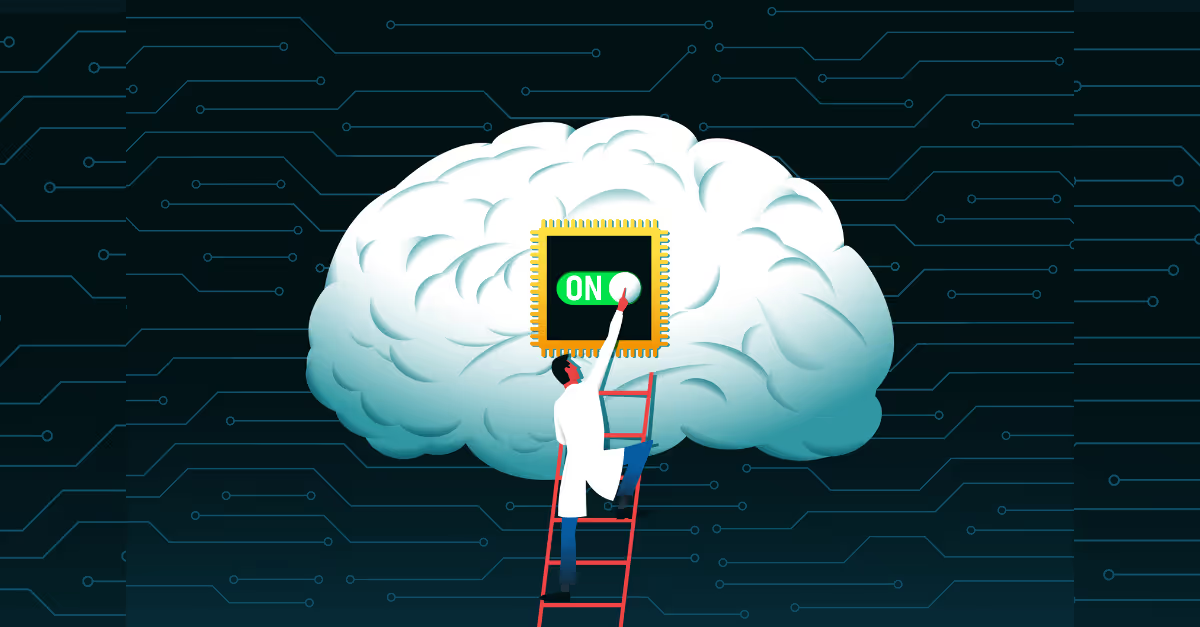Artificial intelligence (AI) agents are revolutionizing the business landscape, offering the potential for increased efficiency, enhanced decision-making, and improved customer experiences.
However, implementing and managing AI agents presents several challenges, including data quality, technology integration, skill shortages, ethical and privacy concerns, and user acceptance.
This blog explores these challenges in detail, providing insights and practical solutions to help businesses navigate the complexities of AI agent deployment.
By overcoming these hurdles, organizations can unlock the full potential of AI agents and achieve a significant return on investment (ROI).
Download the full AI Agents: from AI to ROI Guidebook here.
1. What are AI Agents
AI agents are software entities that interact with their environment and make autonomous decisions to achieve specific objectives. They can learn from their interactions and improve over time through techniques such as machine learning. These agents are often embedded within larger systems and are designed to handle tasks that require human-like reasoning, perception, and decision-making capabilities.
There are a couple of key characteristics to consider:
- Autonomy: AI agents can operate without human intervention, making decisions and acting based on their programming and environment.
- Reactivity: They can perceive their environment and respond in a timely fashion to changes that occur.
- Proactivity: AI agents are goal-oriented, taking initiative and displaying behavior aimed at achieving specific objectives.
- Social ability: Many AI agents can interact with other agents (including humans) to complete tasks or negotiate outcomes.
AI agents are a subset of artificial intelligence, focused specifically on autonomous decision-making and interactions. While AI agents often utilize broader AI technologies (e.g., using NLP to understand user commands or ML to adapt to new situations), the key distinction lies in their autonomy and capability to interact with and navigate their environment independently.
Broader AI technologies might not possess these interactive or autonomous properties and often serve as tools or components within larger systems rather than acting as independent entities.
2. Challenges in Deploying AI Agents
Implementing AI agents presents several hurdles for businesses, each of which can significantly impact the success and efficiency of these technologies. These challenges range from technical difficulties to organizational and ethical issues.
2.1 Data Quality & availability
One of the primary challenges is data quality and availability. AI agents require large amounts of data to train on so that they can make accurate decisions or provide useful interactions.
This data must not only be abundant but also relevant, high-quality, and representative of the scenarios the AI agent will encounter. Many organizations struggle with data that is siloed, incomplete, outdated, or not properly curated, which can lead to poorly performing AI agents that do not meet business needs.
To get the most out of AI agents, you need to make sure your data is top-notch. This means collecting data from trustworthy sources and using the latest methods. You should also set up automatic routines to clean and prep data, getting rid of any inconsistencies or errors.
It's important to use unbiased datasets that cover a wide range of real-world scenarios to make sure the data is relevant and representative. To improve data availability, think about sharing and integrating data across departments and using external data sources.
Finally, continuously monitor and maintain data quality by setting up systems that check for and alert them about any anomalies.
2.2 Technology integration
Integration with existing systems is another significant hurdle. AI agents must often work within the framework of legacy systems that were not designed to support modern AI functionalities. This can involve significant changes to the IT infrastructure, requiring substantial time and financial investment. The integration process can be technically complex and may disrupt existing operations, leading to resistance within the organization.
Integrating AI agents into existing technological frameworks can be complex and costly. Many businesses operate on legacy systems that may not be readily compatible with the latest AI technologies. This incompatibility can lead to several issues, such as disruptions in current processes, increased risk of system failures, and significant costs associated with upgrading or customizing systems to support new AI functionalities.
To mitigate these concerns, businesses must conduct thorough compatibility assessments before implementation. It's also beneficial to collaborate with IT specialists who can create a detailed integration plan that minimizes disruption. Additionally, using API-based AI solutions can offer more flexibility and easier integration with existing systems, reducing both complexity and cost.
2.3 Skill shortages
Skill shortages also pose a substantial barrier. Implementing and managing AI agents requires specialized knowledge in areas like machine learning, data science, and software engineering. However, there is a well-known gap in the availability of professionals who are proficient in these fields. This shortage can delay deployment, increase costs, and reduce the effectiveness of AI implementations.
Addressing skill shortages in the deployment of AI agents is a significant challenge due to the specialized knowledge required in fields like machine learning, data science, and AI integration.
One of the most direct ways to overcome skill shortages is to invest in training and development for existing staff. Businesses can provide specialized training programs to upskill their workforce in areas critical to AI deployment and management. This could include workshops, online courses, certifications, and hands-on projects specifically tailored to the skills needed for working with AI agents, such as programming, data analytics, AI ethics, and system integration.
2.4 Ethical and privacy concerns
Ethical and privacy concerns are increasingly coming to the forefront as AI agents become more prevalent in business operations. These agents often process vast amounts of personal or sensitive data, raising questions about privacy, consent, and data security.
Moreover, if not properly designed, AI agents can inadvertently perpetuate biases present in their training data, leading to unfair outcomes or discrimination. Addressing these issues requires careful planning, legal compliance, and the development of ethical AI frameworks.
2.5 User acceptance
User acceptance and trust can be a hurdle. For AI agents to be effectively integrated into business processes, they must be accepted by the end-users, whether they are customers or employees. People may be skeptical about the reliability of AI agents, concerned about job displacement, or uncomfortable with AI’s perceived intrusiveness. Overcoming this challenge involves transparent communication about the benefits and limitations of AI agents, training for employees, and designing AI agents to be intuitive and user-friendly.
The success of AI agents also heavily depends on their acceptance by end-users, who may be skeptical about new technologies. Concerns often arise over the potential for AI to replace human jobs, as well as apprehensions about privacy and the accuracy of AI decisions. To address these concerns, businesses should focus on transparent communication and education.
Explaining the benefits of AI agents, how they work, and how they are designed to augment human capabilities rather than replace them can help in reducing fears and building trust. It’s also important to involve users in the development and rollout phases, gathering their input and feedback to ensure the solutions meet their needs and are user-friendly. Training sessions and hands-on demonstrations can further enhance user comfort and proficiency with the new technology.
2.6 Scalability
As businesses grow, they often find that AI solutions that worked well at a smaller scale do not perform as expected when expanded. Scalability challenges can manifest in insufficient data processing capabilities, latency issues, and costs that grow faster than expected. To prepare for scalability, it is essential to choose AI platforms and solutions that are designed to grow.
This means selecting AI agents that can handle increased loads and complexities without a drop in performance. Investing in scalable cloud infrastructure can also help, as it allows for flexible resource management and quicker adjustments to varying loads.
Additionally, continuous monitoring and iterative development of AI agents ensure that the systems evolve with the growing needs of the business, adapting to new demands and technologies as required.
3. Investments in AI Agents
3.1 Evaluating Cost vs. Benefit
Implementing AI agents involves various financial considerations that can significantly impact a business's budget and overall financial planning. Understanding these considerations is crucial for ensuring the successful integration and operation of AI agents without unexpected financial strain. You mainly want to compare the initial investments against the potential ROI of your Agent.
Initial investments: The initial investment costs for AI Agents include hardware, software and development. Operational costs include maintenance, energy, and data management. Potentially, you also need to consider some Human Resource costs like training, and hiring external specialists.
ROI considerations: Understanding the potential ROI is essential for businesses to plan effectively and ensure that the implementation of AI agents aligns with their financial capabilities and strategic objectives. Proper budgeting, forecasting, and ROI analysis are crucial to managing these costs and maximizing the benefits of AI technologies.
Main areas where Agents can drive ROI are:
Efficiency Gains: Automation of routine tasks saves time and labor costs.
Revenue Enhancement: Improved customer service and personalized marketing boost revenue.
Risk Mitigation: AI identifies and mitigates risks, saving costs related to fraud and compliance.
Risk of Obsolescence: Rapidly evolving AI tech can become outdated, impacting long-term planning.
Legal and Compliance Costs: Compliance with data protection and ethical standards is necessary to avoid fines.
Let’s take a closer look…
3.2 How to evaluate the potential ROI of AI Agent projects
Evaluating the potential Return on Investment (ROI) of AI agent projects is crucial for businesses to ensure that the benefits outweigh the costs. This assessment involves a blend of quantitative and qualitative criteria that help determine the financial viability and strategic value of implementing AI agents. Here’s a detailed look at these criteria:
Cost Savings
A fundamental criterion for evaluating ROI is the AI agent's capacity to reduce operational costs. This can manifest through automation of routine tasks, which reduces the time and labor costs associated with manual processes. Additionally, AI agents can enhance operational efficiency by streamlining operations to save on resources and overhead. Another significant area is error reduction, where AI can decrease the costs associated with human error in complex tasks, improving overall accuracy and reducing wasteful spending.
Revenue Enhancement
AI agents should also be evaluated based on their potential to generate additional revenue. This could be through improved customer experiences that enhance satisfaction and retention, potentially leading to increased sales. AI can also enable companies to introduce new revenue streams by offering innovative services or products powered by AI. Furthermore, AI can provide a market differentiation factor, using technology to offer unique capabilities that set a business apart from its competitors.
Scalability
The scalability of an AI project is a critical criterion, especially in dynamic market environments. This includes assessing the AI system’s flexibility to adapt to changing business sizes and needs without incurring significant additional costs. Another aspect is the ease of integration with existing systems and processes, which facilitates growth and expansion without substantial disruptions.
Competitive Advantage
Evaluating AI projects also involves determining their potential to provide a competitive advantage. This could be reflected in faster processing and response times leading to quicker decision-making and enhanced market responsiveness. AI can also foster innovation by deploying cutting-edge technology that has the potential to disrupt traditional business models or create new industry standards.
Risk Reduction
Assessing how well AI agents can mitigate operational and financial risks is another vital criterion. AI can enhance predictive analytics capabilities, allowing businesses to foresee and mitigate potential risks. Additionally, AI can improve compliance and security measures, helping businesses meet regulatory requirements more efficiently and protect against cyber threats.
Customer Satisfaction and Engagement
The impact of AI on customer relationships is significant and should be evaluated. AI can personalize customer interactions, delivering tailored experiences that increase loyalty and the lifetime value of customers. It can also improve the quality of customer service by increasing the responsiveness and effectiveness of support operations.
Employee Productivity and Satisfaction
The influence of AI on the workforce is also crucial. AI agents can empower employees by providing tools that help them perform their jobs more effectively, which can lead to higher productivity and job satisfaction. Moreover, AI presents opportunities for staff to upgrade their skills and engage in more strategic, value-added work, enhancing overall job satisfaction.
4. Measuring the ROI of AI Agents
Quantifying the returns from investing in AI agents involves employing methodologies that measure both direct financial outcomes and broader impacts on business performance. Here’s a detailed look at several effective methodologies to assess ROI for AI initiatives:
4.1 Cost-Benefit Analysis (CBA)
Cost-Benefit Analysis is a classic financial tool used to compare the costs of an AI initiative against the benefits it delivers. This involves:
Calculating all costs associated with implementing and running the AI agents, including upfront investments, ongoing operational costs, and any hidden costs like training or increased energy consumption.
Estimating tangible benefits such as increased revenue from enhanced sales, savings from automation of manual tasks, and cost avoidance from improved accuracy and efficiency.
Quantifying intangible benefits, which might include improved customer satisfaction, brand reputation, or employee morale.
The result is a clear financial metric that indicates whether the benefits outweigh the costs and by how much.
4.2 Return on Investment (ROI) Calculation
Return on Investment is a straightforward metric calculated by dividing the net benefits of an investment (total benefits minus total costs) by the total costs of the investment, often expressed as a percentage:
ROI = (Net Benefits / Total Costs) ×100
For AI projects, ROI helps in understanding the efficiency of the investment in generating returns.
4.3 Payback Period
This metric determines how long it takes for an AI initiative to recoup its initial investment costs through net benefits (savings and additional earnings). A shorter payback period is generally more favorable as it indicates quicker recovery of the investment, reducing financial risk and improving cash flow.
4.4 Total Cost of Ownership (TCO)
Total Cost of Ownership includes all costs related to the AI system over its lifecycle, from initial design and implementation to maintenance and eventual decommissioning. Comparing TCO with the total benefits over the same period can provide a comprehensive view of the long-term value of the investment.
Key Performance Indicators (KPIs) are vital for measuring the success and efficiency of AI agent deployments. These metrics help businesses to track performance, identify areas for improvement, and justify the investment in AI technologies.
Discover our 10 best KPIs to measure the deployment success of AI Agents.
5. Best practices for maximizing ROI from AI Agents
Maximizing the Return on Investment (ROI) from AI agents involves adopting a strategic approach that encompasses planning, execution, and continuous improvement. Here are some best practices that can help businesses achieve the greatest value from their AI initiatives:
1. Align AI Initiatives with Business Objectives
Start by ensuring that your AI projects are tightly aligned with broader business goals. This alignment helps ensure that the AI agents are solving relevant business problems and contributing directly to strategic objectives, whether it's increasing efficiency, improving customer satisfaction, or driving revenue growth.
2. Choose the Right Use Cases
Select use cases where AI can provide clear and measurable benefits. Prioritize projects based on their potential impact and feasibility. High-impact, low-complexity projects are ideal starting points as they are more likely to produce quick wins that can justify further investment in AI.
3. Ensure Quality Data
The accuracy and effectiveness of AI agents largely depend on the quality of the data they are trained on. Invest in robust data management practices, including data cleaning, integration, and enrichment, to ensure that the AI systems have access to high-quality, relevant, and unbiased data.
4. Focus on Scalability and Flexibility
Design AI solutions with scalability in mind to accommodate future growth and changes. Using modular architectures and cloud services can help ensure that your AI systems can scale up or down as needed without significant additional investment.
5. Integrate with Existing Systems
Ensure that AI agents are seamlessly integrated with existing IT infrastructure. Proper integration enhances the agents’ usability and allows them to leverage data from across the organization, improving outcomes and user acceptance.
6. Monitor and Optimize Performance
Continuously monitor the performance of AI agents using the KPIs established during the planning phase. Use this data to optimize the models and operations continually. This iterative process helps in refining AI strategies and improving their effectiveness over time.
7. Foster AI Literacy and Collaboration
Developing AI literacy within the organization is crucial. Offer training and development opportunities to help staff understand and work effectively with AI technologies. Encourage collaboration between AI specialists and other departments to ensure that AI solutions are well understood and effectively utilized across the organization.
8. Manage Change Effectively
Implement change management practices to address the human aspects of AI adoption. This includes communicating the benefits of AI to all stakeholders, addressing any concerns about job displacement, and redefining roles to work effectively with AI technologies.
9. Uphold Ethical Standards and Compliance
Adhere to ethical guidelines and legal standards concerning AI use. This includes respecting privacy, ensuring data security, and avoiding biased outcomes. Ethical AI practices not only prevent regulatory penalties but also build trust with customers and employees.
10. Measure and Communicate ROI
Regularly measure the ROI of AI initiatives and communicate these results to stakeholders. Transparent reporting on AI’s performance and business impact helps justify ongoing and future investments in AI technologies.
11. Leverage External Expertise
Consider partnering with external experts or consultants who can provide specialized knowledge and insights that may be lacking internally. These partnerships can help accelerate AI projects and increase their chances of success.
By following these best practices, businesses can maximize the ROI from their AI agents, ensuring that these technologies contribute positively to operational efficiency, customer satisfaction, and competitive advantage.
Conclusion
In conclusion, the integration of AI agents into business operations presents a transformative opportunity for organizations across various industries. As we've explored in this blog, AI agents offer remarkable capabilities—from automating routine tasks and enhancing customer interactions to driving innovations and operational efficiencies.
However, the deployment of these agents comes with its set of challenges, including data management, technology integration, skill shortages, and ethical considerations, all of which require thoughtful planning and strategic management.
Download the full AI Agents: from AI to ROI Guidebook here.






















